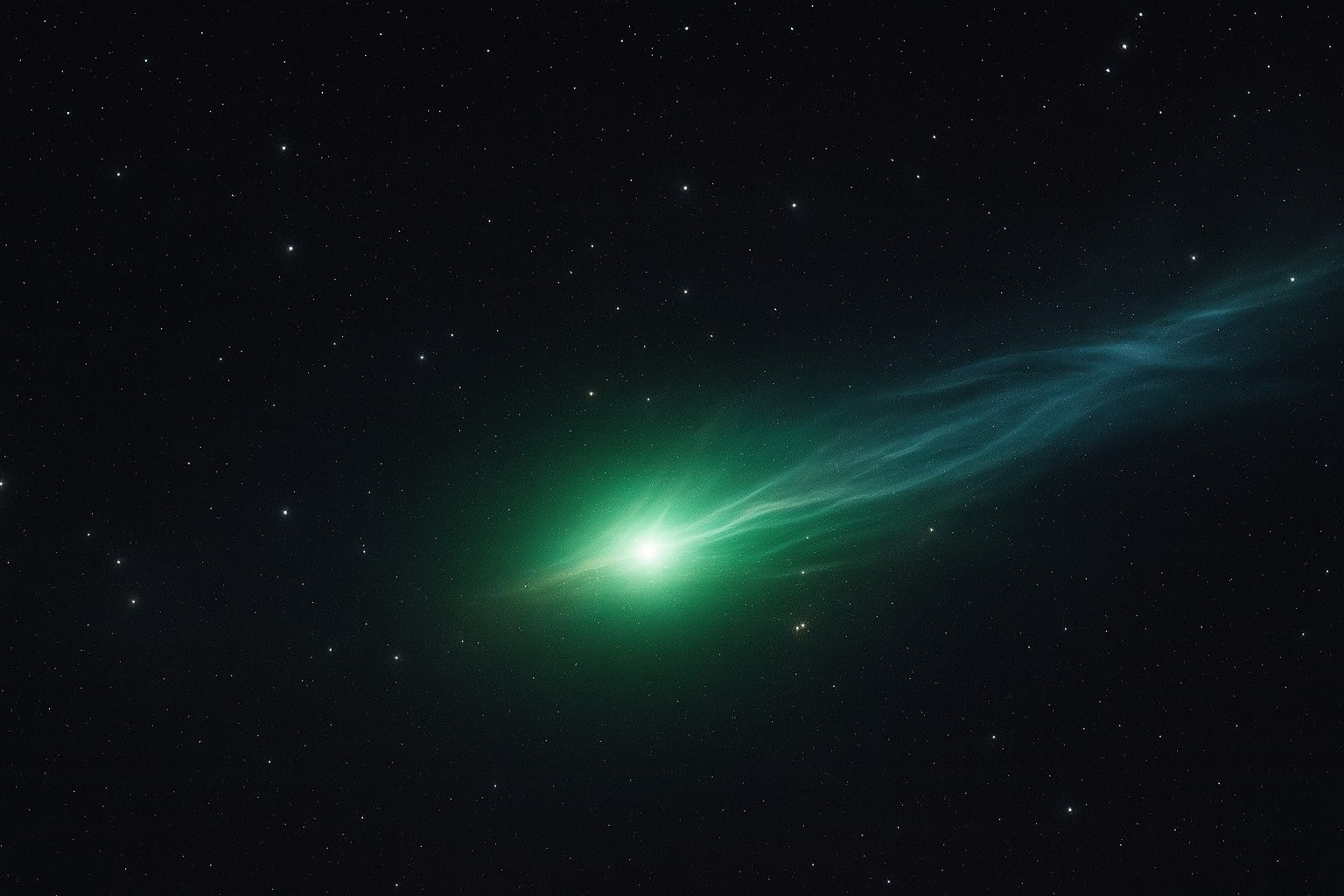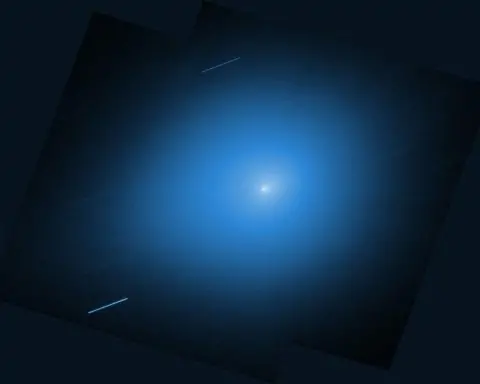15 November 2025 – Interstellar comet 3I/ATLAS has survived its close swing past the Sun, grown a spectacular ion tail, emitted its first detected radio signal, and had its orbit nailed down with help from a spacecraft at Mars. At the same time, the object is fueling another round of online “alien probe” speculation – which new data strongly undercuts.
Here’s a deep, news-style roundup of everything we know about 3I/ATLAS as of today and what skywatchers can actually do with it tonight.
Key facts about 3I/ATLAS at a glance (15 November 2025)
- What it is: A genuinely interstellar comet – the third known object from outside our solar system, after 1I/ʻOumuamua and 2I/Borisov. [1]
- Discovery: First reported on 1 July 2025 by NASA‑funded ATLAS (Asteroid Terrestrial‑impact Last Alert System) in Chile. [2]
- Path: On a hyperbolic trajectory – it’s just passing through and will never return. [3]
- Closest to the Sun (perihelion): 29–30 October 2025 at about 1.36–1.4 AU (just outside Mars’ orbit). [4]
- Closest to Earth (future): Around 19 December 2025, still a distant ~1.8 AU (≈270 million km) away – no impact risk. [5]
- Where it is today: In the constellation Virgo, about 2.1 AU from Earth, with a latest reported magnitude near 9.8 – strictly a telescope object. [6]
- Why it’s special: Chemistry and colour are very odd (CO₂‑rich, nickel‑rich, “red and dusty”) and its orbit suggests it could be older than the solar system – possibly several billion years old. [7]
Today’s headlines: survival, speculation and a clearer picture
1. “Survived the Sun” – and sparked more alien chatter
Indian and international outlets today highlight that 3I/ATLAS has emerged intact from behind the Sun after its late‑October perihelion, keeping its bright blue‑green coma and dusty tail. [8]
An article in The Economic Times describes how the comet’s survival, strong jets and unusual colour have kept debates about its origin alive, quoting those who see its structural toughness as “weird,” while also noting that radio observations indicate normal cometary water loss. [9]
Zee News similarly focuses on new images that show 3I/ATLAS “survived the Sun against all odds,” reigniting social‑media speculation about an “engineered” object. [10]
Crucially, none of the new data supports an artificial origin, and several major studies published in the last few days actually push in the opposite direction (more on that below).
2. NASA’s new FAQ: “It’s a comet, it’s interstellar, and it’s not dangerous”
Yesterday, NASA quietly published a detailed “3I/ATLAS Facts and FAQs” page – now one of the most authoritative summaries of what’s known. [11]
Key takeaways:
- 3I/ATLAS is unambiguously a comet, with an icy nucleus surrounded by an active coma of gas and dust.
- It’s travelling at over 150,000 mph (≈246,000 km/h) near perihelion and is moving too fast to be bound by the Sun’s gravity – hence its interstellar status. [12]
- Its closest distance to Earth will still be nearly twice the Earth–Sun distance on 19 December 2025. There is no scenario where it hits Earth. [13]
- NASA stresses that any slight deviations from its predicted path are small, expected perturbations caused by normal outgassing, not mysterious forces. [14]
For anyone wondering if 3I/ATLAS could be a threat, NASA’s updated page is essentially a firm “no.”
3. ESA nails down the orbit using a spacecraft at Mars
On 14 November 2025, the European Space Agency (ESA) announced that it has improved predictions of 3I/ATLAS’s position by a factor of ten, thanks to clever use of the ExoMars Trace Gas Orbiter (TGO) orbiting Mars. [15]
- Between 1–7 October, TGO turned its camera away from Mars and toward 3I/ATLAS as it passed within about 29 million km of the Red Planet. [16]
- Combining that vantage point with Earth‑based observations allowed scientists to triangulate the comet’s path and dramatically shrink the positional uncertainty. [17]
- ESA emphasises that this is a planetary‑defence rehearsal, even though 3I/ATLAS itself is harmless. It’s the first time astrometric measurements from a spacecraft orbiting another planet have been officially used by the Minor Planet Center. [18]
Better orbit predictions mean better science: observatories can point more accurately at this fast‑moving target as it recedes from the Sun.
4. First radio signal from 3I/ATLAS – and what it really means
The most buzz‑worthy development this week was the announcement that astronomers using South Africa’s MeerKAT radio telescope have detected the first radio signal from 3I/ATLAS. [19]
What was actually detected?
- MeerKAT picked up radio emission from hydroxyl (OH) radicals in the comet’s coma – the gas and dust cloud around the nucleus. [20]
- OH is produced when sunlight breaks apart water vapour escaping from the comet – a classic signature of normal cometary activity.
- The signal is at well-known frequencies (around 1665 and 1667 MHz) already familiar from comets in our own solar system. [21]
The Times of India explicitly notes that this radio detection confirms 3I/ATLAS is a natural comet, not an alien probe, while also reinforcing that it likely formed billions of years ago in another star system. [22]
ScienceAlert, in a separate analysis, stresses the same point: radio “signals” are exactly what you expect when you point a radio telescope at an outgassing comet. There is nothing in the data that looks like engineered communication. [23]
5. “Non‑gravitational acceleration” explained without exotic physics
A fresh study covered yesterday by IFLScience tackles another favourite talking point of alien‑probe fans: the small but measurable non‑gravitational acceleration of 3I/ATLAS. [24]
- Using thermophysical and Monte Carlo models, researcher Florian Neukart shows that the observed accelerations can be explained by ordinary outgassing of CO and CO₂ from a small fraction of the surface. [25]
- The paper concludes that a “purely physical volatile‑driven mechanism” reproduces both the magnitude and direction of the acceleration – no exotic “light‑sail” or alien technology required. [26]
- The same article notes that MeerKAT’s OH detection fits neatly into the picture of a very active comet shedding water as it warms. [27]
Taken together with NASA’s FAQ, the new modelling strongly reinforces the comet‑not‑spacecraft interpretation.
6. Tail growth, jets and spectacular new images
Visually, 3I/ATLAS is putting on a show – for large telescopes, at least.
- On 12 November, Space.com highlighted a new Virtual Telescope Project image showing the comet’s ion tail growing dramatically longer and more structured as it recedes from the Sun. The tail stretches roughly 0.7° across the sky, with a faint “anti‑tail” visible in the opposite direction. [28]
- An EarthSky report shows 3I/ATLAS displaying multiple jets – thin streams of material fanning out from the nucleus – in early November, shortly after perihelion. [29]
- BBC Sky at Night Magazine has compiled a gallery of images from Hubble, the Very Large Telescope, Gemini and other facilities, tracking the comet from its July discovery through its current, much more active phase. [30]
These features – long ion tail, anti‑tail, multiple jets – look dramatic but are normal for active comets, especially ones getting a lot of solar heating. Scientists are especially interested because this is the first interstellar comet we can study in such detail from the ground. [31]
7. HiRISE images from Mars: coming soon
In a new piece published today, astrophysicist Avi Loeb writes that NASA is expected to release HiRISE images of 3I/ATLAS “within a few days”, taken by the Mars Reconnaissance Orbiter when the comet passed near Mars in early October. [32]
According to Loeb:
- HiRISE should provide a side‑on view of the comet’s anti‑tail and jets with roughly 30 km per pixel resolution, complementing earlier Hubble images. [33]
- Those data will help refine estimates of the nucleus size and clarify the geometry of the dust structures.
Loeb has been one of the loudest proponents of a possible artificial origin, but even in this article he frames the new images as a way to constrain physical properties, not as proof of alien technology. [34]
Where is 3I/ATLAS today and how can you see it?
Current position and brightness
Live ephemeris from TheSkyLive shows 3I/ATLAS today (15 November 2025): [35]
- Constellation: Virgo
- Distance from Earth: ~2.1 AU (~315 million km)
- Distance from Sun: just beyond Mars’ orbit, heading outward
- Apparent magnitude: about 9.8 (subject to change as activity evolves)
That brightness is far too faint for the naked eye, but reachable with decent amateur equipment.
Viewing tips (for experienced observers)
Based on guidance from NASA, EarthSky, BBC Sky at Night and recent ephemerides: [36]
- When to look:
- Best in the pre‑dawn hours, a couple of hours before local sunrise, while Virgo is above the eastern or south‑eastern horizon (exact timing depends on your location).
- What you need:
- At least a small to medium telescope; EarthSky suggests ~8‑inch (20 cm) aperture or larger for a reliable visual detection. [37]
- What you’ll see:
- A faint, fuzzy “star” with a small coma. Imaging with long exposures can reveal the slender ion tail; visually, the tail will be subtle under most conditions. [38]
NASA notes that 3I/ATLAS should remain observable in small telescopes into spring 2026, gradually fading as it heads out toward Jupiter’s orbit and beyond. [39]
What makes 3I/ATLAS so unusual?
Several lines of evidence show that this is not just any comet – it’s a physical outlier even among interstellar visitors.
- Strange chemistry
- Observations from the James Webb Space Telescope and other facilities show 3I/ATLAS is unusually rich in carbon dioxide relative to water, with a noticeable amount of nickel and a deficit of some common carbon‑chain molecules. [40]
- That composition suggests it formed far from its parent star, beyond the CO₂ “frost line”, in extremely cold conditions. [41]
- Colour and radiation history
- The comet appears red and dusty, likely because its surface has been irradiated by cosmic rays for billions of years in deep space. [42]
- Ancient origin
- Dynamical and population studies suggest 3I/ATLAS could be 3–14 billion years old and may belong to the Milky Way’s thick disk population – implying it might be older than the solar system and possibly one of the oldest comets ever observed. [43]
- Extreme speed
- Its incoming speed and hyperbolic orbit show it didn’t get kicked to these velocities by any planet in our system; it was ejected from another star’s planetary system long ago and has been wandering the galaxy ever since. [44]
- Anti‑tail and jets
- High‑resolution images show an anti‑tail (apparent tail pointing toward the Sun due to perspective) and multiple jets, giving the comet a complex, almost engineered look – but each of these features has well‑understood, natural explanations. [45]
In other words: 3I/ATLAS is deeply weird, but in an astrophysically satisfying way.
Aliens or ice? How scientists are handling the speculation
The “alien spacecraft” narrative has been propelled largely by high‑profile commentary, notably from Avi Loeb and the Initiative for Interstellar Studies, who previously argued that some of 3I/ATLAS’s properties were “anomalous.” [46]
Over the past week, though, a series of independent results have:
- Explained the radio signal as standard OH emission from water activity (MeerKAT). [47]
- Explained the acceleration using normal CO/CO₂ outgassing (Neukart’s modelling). [48]
- Reinforced the cometary composition with detailed spectroscopy (JWST, Hubble, VLT, Gemini). [49]
- Clarified that its structural behaviour so far looks like a “healthy comet,” not a rigid craft, according to comet experts quoted by ScienceAlert and other outlets. [50]
ScienceAlert summarised the mood among many astronomers this week: every data point so far is consistent with “a really peculiar comet” rather than anything engineered. [51]
For readers, the key is to separate speculative opinion pieces from the body of observational evidence now coming in from radio telescopes, deep‑space observatories and planetary missions.
Don’t confuse it with the other “comet ATLAS”
To add to the public confusion, there is another active comet in the sky right now: C/2025 K1 (ATLAS), sometimes called the “other ATLAS comet.” [52]
- C/2025 K1 is a solar‑system comet that recently developed a golden glow and has begun breaking apart after a much closer pass to the Sun. [53]
- Headlines about a “gold” ATLAS comet or one “splitting into pieces” are typically referring to C/2025 K1, not 3I/ATLAS. [54]
3I/ATLAS is the interstellar one – older, faster, and on a one‑time fly‑through of the solar system.
What comes next for 3I/ATLAS?
Even though perihelion is behind us, the science is just getting started:
- JWST observations in December will probe the comet’s detailed composition as it cools and moves away from the Sun. [55]
- ESA’s JUICE spacecraft is currently observing the comet from its distant vantage point, with data expected in early 2026. [56]
- HiRISE images from Mars Reconnaissance Orbiter are expected to be released soon, giving a unique side‑on look at the jets and anti‑tail. [57]
- Ground‑based telescopes and amateur observers will track 3I/ATLAS into spring 2026, squeezing out every photon before it fades beyond practical reach. [58]
- Some mission concepts are already being discussed in the literature for future encounters with interstellar comets, inspired by objects like 3I/ATLAS. [59]
For now, 3I/ATLAS is a once‑in‑a‑civilisation laboratory: a chunk of another planetary system, older than our own, venting its ancient ices under our Sun.
If you have access to a telescope and dark skies, catching even a faint glimpse of its fuzzy glow over the next few weeks means you’re seeing material that formed around a completely different star, billions of years ago – no aliens required.
References
1. science.nasa.gov, 2. science.nasa.gov, 3. science.nasa.gov, 4. science.nasa.gov, 5. science.nasa.gov, 6. theskylive.com, 7. en.wikipedia.org, 8. m.economictimes.com, 9. m.economictimes.com, 10. zeenews.india.com, 11. science.nasa.gov, 12. science.nasa.gov, 13. science.nasa.gov, 14. science.nasa.gov, 15. www.esa.int, 16. www.esa.int, 17. www.esa.int, 18. www.esa.int, 19. www.discovermagazine.com, 20. timesofindia.indiatimes.com, 21. www.sciencealert.com, 22. timesofindia.indiatimes.com, 23. www.sciencealert.com, 24. www.iflscience.com, 25. www.iflscience.com, 26. www.iflscience.com, 27. www.iflscience.com, 28. www.space.com, 29. earthsky.org, 30. www.skyatnightmagazine.com, 31. www.space.com, 32. avi-loeb.medium.com, 33. avi-loeb.medium.com, 34. avi-loeb.medium.com, 35. theskylive.com, 36. science.nasa.gov, 37. earthsky.org, 38. www.space.com, 39. science.nasa.gov, 40. weather.com, 41. en.wikipedia.org, 42. www.sciencealert.com, 43. en.wikipedia.org, 44. science.nasa.gov, 45. www.space.com, 46. en.wikipedia.org, 47. timesofindia.indiatimes.com, 48. www.iflscience.com, 49. www.sciencealert.com, 50. www.sciencealert.com, 51. www.sciencealert.com, 52. www.livescience.com, 53. www.livescience.com, 54. www.livescience.com, 55. weather.com, 56. www.esa.int, 57. avi-loeb.medium.com, 58. science.nasa.gov, 59. www.esa.int










